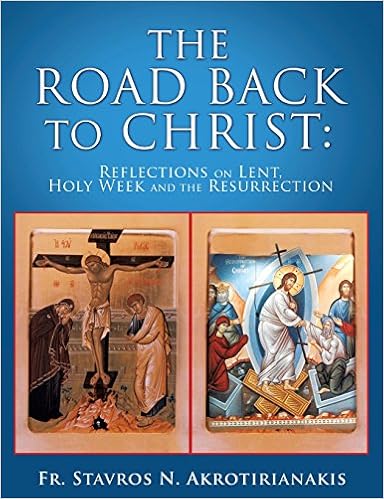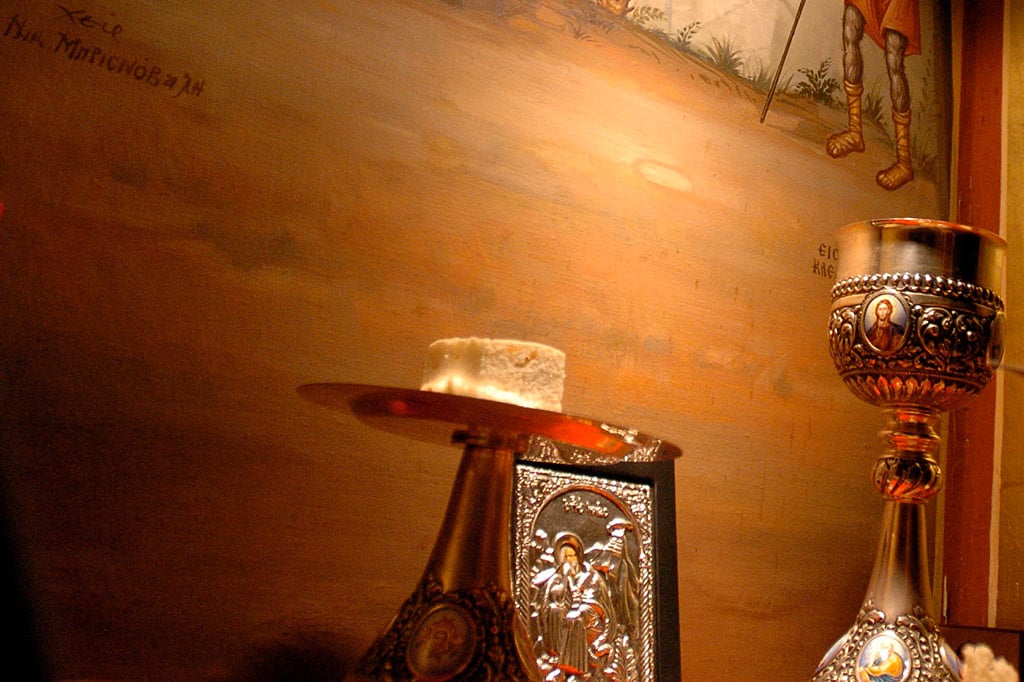Now as they were eating, Jesus took bread, and blessed, and broke it,
and gave it to the disciples and said, "Take, eat; this is My body." And He took a cup,
and when He had given thanks He gave it to them, saying, ''Drink of it, all of you; for this
is My blood of the new covenant, which is poured out for many for the forgiveness of sins.
I tell you I shall not drink again of this fruit of the vine until that day when
I drink it new with you in my Father's kingdom."
Matthew 26:26-29
(From the Gospel of the Vesperal Liturgy on Holy Thursday)
A "covenant" is a sacred or solemn agreement. The first covenant was made between God and Abraham. In Genesis 17, "The Lord appeared to Abram, and said to him, I am God Almighty; walk before Me and be blameless. And I will make My covenant between Me and you, and will multiply you exceedingly...behold, My covenant is with you, and you shall be father of a multitude of nations...I will make you exceedingly fruitful; and I will make nations of you and kings shall come forth from you. And I will establish My covenant between Me and you, and kings shall come forth from you. And I will establish My covenant between Me and you and your descendants after you throughout their generations for an everlasting covenant, to be God to you and to your descendants after you."' (v. 1-7)
As a sign of this covenant between God and His people, the Lord required that all males be circumcised ( Gen. 17: 10-14). This was a sacrifice that required the shedding of blood of each male child. There were other sacrifices, which involved blood as well-rams and bulls and lambs-offered to the Lord as atonement for sin. Even a happy occasion like the birth of a child required an offering of pigeons or doves (Lev. 12).
After the people of Israel were given the Ten Commandments by God through Moses, He commanded them to build an "Ark" in which to keep the Ten Commandments, called the "Ark of the Covenant" (Exod. 25). This "ark" was carried everywhere as a reminder to the people of the covenant between them and the Lord. It was a covenant based on God's love, but practically speaking, it was centered on the Ten Commandments, as well as blood sacrifices to God, a large part of the Law.
At the Last Supper, Jesus instituted a New Covenant. He took bread and wine and offered them to the Disciples, as His Body and Blood. The next day, He shed His blood on the cross for our sins. Whoever, then, partakes of the Body and Blood of Christ, is a participant in the New Covenant.
The New Covenant is without bloodshed. Because Christ shed His Blood for us, there is no need for us to shed any blood for Him or as atonement for sins. Saint Paul writes in Galatians 6: 15, ''For neither circumcision counts for anything, nor uncircumcision, but a new creation."We are no longer circumcised for religious reasons. In Romans 2, we read "nor is true circumcision something external and physical . .. real circumcision is a matter of the heart, spiritual and not literal" ( v. 28-29). We are no longer circumcised in the flesh, but through baptism (our initiation into the faith) and through the Eucharist (what sustains our faith), we experience a circumcision, or changing, of our hearts.
The Eucharist is a "bloodless" sacrifice, where we present bread and wine to the Lord, and through the Grace of the Holy Spirit, these "gifts" are "consecrated" to become the Body and Blood of Christ. We then partake of them, so that we have the opportunity to touch the Divine God and for the Divine God to touch us.
In Hebrews 9:6-7, we read "These preparations having thus been made, the priests go continually into the outer tent, performing their ritual duties; but into the second only the high priest goes, and he but once a year, and not without taking blood, which he offers for himself and for the errors of the people. Continuing on, we read in Hebrews 9: 11-12: ''But when Christ appeared as a high priest of the good things that have come, then through the greater and more perfect tent (not made with hands, that is, not of this creation), He entered once for all into the Holy Place, taking not the blood of goats and calves but His own blood, thus securing an eternal redemption."
The Old Covenant taught us to live in obedience. The New Covenant is to live in love. In the Old Covenant, the people did not have access to the Holy of Holies, only the high priest and he only had access once a year. In the New Covenant, we are welcome to approach Christ in the Eucharist, as many times as we wish.
In the New Covenant, we are to live in Christ, in the way that He lived. We are to be walking "temples" of His love. Through the Eucharist, Christ can live in us. Through continual partaking in the Eucharist, we strengthen our bond with Christ. This is why the Eucharist is offered so frequently.
In Hebrews 9:28, we read that "Christ, having been offered once to bear the sins of many, will appear a second time, not to deal with sin, but to save those who are eagerly waiting/or Him."The Christian life, then, is not a fearful obedience to rules, but an eager awaiting for Christ to return, and in preparation, we partake of Him continually in the Eucharist. If we believe that heaven is the place where we will partake in divine nature on a permanent basis, meaning that once we go to heaven, we will never suffer the human condition again (sickness, dying, sinning, etc.), then in order to prepare to live with Christ eternally, He gave to us an opportunity to partake of Divine Nature in this life, in the institution of the Eucharist.
The Old Covenant called people to moral living. This was done through obedience to commandments. The New Covenant calls us to eternal life. We honor this covenant through partaking of Christ in the Eucharist.
In our churches, we have a tabernacle on the altar table, as a visual reminder of the New Covenant. It no longer contains the Ten Commandments, but the Body and Blood of Christ, as a reminder that Christ is always present in our churches and in our lives and that we should be eagerly partaking of Him on a continual basis, in preparation for living on a permanent basis in His Heavenly Kingdom.
Receive me today, O Son of God, as a partaker of Your Mystical Supper;
for I will not speak of the Mystery to Your enemies;
nor will I kiss You as did Judas; but as the thief I confess You.
"Lord, remember me when You come into Your Kingdom."
(From the Vesperal Liturgy on Holy Thursday Morning, Trans. by Fr. George Papadeas)
Live in Christ today! Invite Him continually to live in you!
We encourage you to participate in this journey guided by Fr. Stavros in two ways:
Purchase the book "The Road Back to Christ: Reflections on Lent, Holy Week and the Resurrection" by Fr. Stavros N. Akrotirianakis
Join the Prayer Team Daily Devotion email list and receive a reflection like this in your inbox every morning
About Great Lent, Holy Week, and Pascha
There is a 19 Sunday (18 week) period of time each year in the Orthodox Christian Church that surrounds the Feast of Pascha (Easter). The first three weeks, including four Sundays, are called the Triodion, or pre-Lenten period. The next forty days, which includes nearly six weeks and five Sundays, is called Great Lent. In the Orthodox Church, Great Lent begins on a Monday called Clean Monday, rather than Ash Wednesday, as it does in other churches. Great Lent ends on a Friday.
Holy Week follows, along with the Great and Holy Week.
The Feast of the Resurrection is called Pascha and it begins a forty-day period of celebration. After forty days, the church celebrates the Feast of the Ascension. Ten days later (fifty days after the Resurrection), the church celebrates the Feast of Pentecost. The Sunday after Pentecost is the Feast of All Saints. This ends this cycle of "movable feasts" (called this because their date moves every year), which surround the feast of Pascha.
 About "The Road Back to Christ"
About "The Road Back to Christ"
The Road Back to Christ: Reflections on Lent, Holy Week and the Resurrection is a series of short daily reflections on the scripture readings of Holy Week and the accounts of the Resurrection and post-Resurrection appearances of Christ. Designed to guide its readers through the journey, it will both inspire and reinvigorate your faith through meditation, prayer, and a deeper understanding of the Passion and Resurrection of Jesus Christ.
About Fr. Stavros
Fr. Stavros Akrotirianakis is the Proistamenos (Presiding Priest) at St. John the Baptist Greek Orthodox Church in Tampa, FL.
